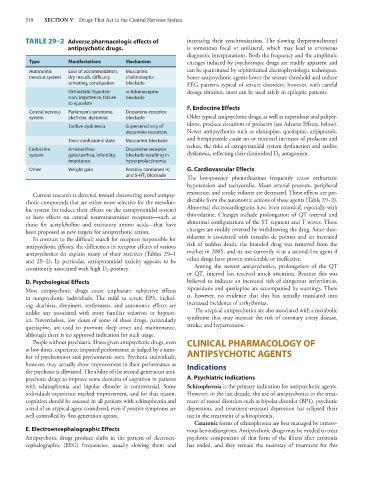Page 532 - Basic _ Clinical Pharmacology ( PDFDrive )
P. 532
518 SECTION V Drugs That Act in the Central Nervous System
TABLE 29–2 Adverse pharmacologic effects of increasing their synchronization. The slowing (hypersynchrony)
antipsychotic drugs. is sometimes focal or unilateral, which may lead to erroneous
diagnostic interpretations. Both the frequency and the amplitude
Type Manifestations Mechanism changes induced by psychotropic drugs are readily apparent and
Autonomic Loss of accommodation, Muscarinic can be quantitated by sophisticated electrophysiologic techniques.
nervous system dry mouth, difficulty cholinoceptor Some antipsychotic agents lower the seizure threshold and induce
urinating, constipation blockade EEG patterns typical of seizure disorders; however, with careful
Orthostatic hypoten- α-Adrenoceptor dosage titration, most can be used safely in epileptic patients.
sion, impotence, failure blockade
to ejaculate
Central nervous Parkinson’s syndrome, Dopamine-receptor F. Endocrine Effects
system akathisia, dystonias blockade Older typical antipsychotic drugs, as well as risperidone and paliper-
idone, produce elevations of prolactin (see Adverse Effects, below).
Tardive dyskinesia Supersensitivity of
dopamine receptors Newer antipsychotics such as olanzapine, quetiapine, aripiprazole,
Toxic-confusional state Muscarinic blockade and brexpiprazole cause no or minimal increases of prolactin and
reduce the risks of extrapyramidal system dysfunction and tardive
Endocrine Amenorrhea- Dopamine-receptor
system galactorrhea, infertility, blockade resulting in dyskinesia, reflecting their diminished D antagonism.
2
impotence hyperprolactinemia
Other Weight gain Possibly combined H 1 G. Cardiovascular Effects
and 5-HT 2 blockade
The low-potency phenothiazines frequently cause orthostatic
hypotension and tachycardia. Mean arterial pressure, peripheral
Current research is directed toward discovering novel antipsy- resistance, and stroke volume are decreased. These effects are pre-
chotic compounds that are either more selective for the mesolim- dictable from the autonomic actions of these agents (Table 29–2).
bic system (to reduce their effects on the extrapyramidal system) Abnormal electrocardiograms have been recorded, especially with
or have effects on central neurotransmitter receptors—such as thioridazine. Changes include prolongation of QT interval and
those for acetylcholine and excitatory amino acids—that have abnormal configurations of the ST segment and T waves. These
been proposed as new targets for antipsychotic action. changes are readily reversed by withdrawing the drug. Since thio-
In contrast to the difficult search for receptors responsible for ridazine is associated with torsades de pointes and an increased
antipsychotic efficacy, the differences in receptor effects of various risk of sudden death, the branded drug was removed from the
antipsychotics do explain many of their toxicities (Tables 29–1 market in 2005, and its use currently is as a second-line agent if
and 29–2). In particular, extrapyramidal toxicity appears to be other drugs have proven intolerable or ineffective.
consistently associated with high D potency. Among the newest antipsychotics, prolongation of the QT
2
or QT interval has received much attention. Because this was
c
D. Psychological Effects believed to indicate an increased risk of dangerous arrhythmias,
Most antipsychotic drugs cause unpleasant subjective effects ziprasidone and quetiapine are accompanied by warnings. There
in nonpsychotic individuals. The mild to severe EPS, includ- is, however, no evidence that this has actually translated into
ing akathisia, sleepiness, restlessness, and autonomic effects are increased incidence of arrhythmias.
unlike any associated with more familiar sedatives or hypnot- The atypical antipsychotics are also associated with a metabolic
ics. Nevertheless, low doses of some of these drugs, particularly syndrome that may increase the risk of coronary artery disease,
quetiapine, are used to promote sleep onset and maintenance, stroke, and hypertension.
although there is no approved indication for such usage.
People without psychiatric illness given antipsychotic drugs, even CLINICAL PHARMACOLOGY OF
at low doses, experience impaired performance as judged by a num-
ber of psychomotor and psychometric tests. Psychotic individuals, ANTIPSYCHOTIC AGENTS
however, may actually show improvement in their performance as Indications
the psychosis is alleviated. The ability of the second-generation anti-
psychotic drugs to improve some domains of cognition in patients A. Psychiatric Indications
with schizophrenia and bipolar disorder is controversial. Some Schizophrenia is the primary indication for antipsychotic agents.
individuals experience marked improvement, and for that reason, However, in the last decade, the use of antipsychotics in the treat-
cognition should be assessed in all patients with schizophrenia and ment of mood disorders such as bipolar disorder (BP1), psychotic
a trial of an atypical agent considered, even if positive symptoms are depression, and treatment-resistant depression has eclipsed their
well controlled by first-generation agents. use in the treatment of schizophrenia.
Catatonic forms of schizophrenia are best managed by intrave-
E. Electroencephalographic Effects nous benzodiazepines. Antipsychotic drugs may be needed to treat
Antipsychotic drugs produce shifts in the pattern of electroen- psychotic components of that form of the illness after catatonia
cephalographic (EEG) frequencies, usually slowing them and has ended, and they remain the mainstay of treatment for this

